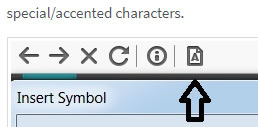Moodle and Respondus. This exam is administered via the Class Moodle utilizing Respondus Browser Lockdown technology. Be sure you have taken the practice quiz (also via the class Moodle) prior to starting the hourly exam so that you are sure your computer technology will function correctly and that you know how to create Spanish diacritics.
Keyboard. Be sure that you are following the syllabus directives on creating diacritics (tildes and stress marks) with your computer. This is the most efficient way to create those special characters. If that is not working click on the "special symbols" icon in the Lockdown Browser to insert what you need (e.g. the "¡"). You will not be able to leave the exam to browse out and follow the instructions to install the keyboard for Windows or learn the key strokes for an Apple device. Chromebooks will not function with Respondus/Monitor.
Procedure. You will be taking the exam sequentially, meaning you will not be able to skip back and forth between pages. Pages will contain 3-5 sections of the exam. You will start with the listening comprehension section (the audio will begin automatically and you will not be able to pause, stop or repeat it). When you move to the next page of the exam you will not be able to return to a previous page. (Note: If you do not put any text in your virtual piece of paper question, then as you submit the exam you will be warned that you left a question blank.)
Code of Student Conduct. As you begin this test we want to be clear that we expect the same standard of ethical behavior from you for this exam as we do for any other exam or assignment that you submit--We expect you to follow the NCSU Code of Student Conduct. Specifically, we ask you to verify that:
- you have not received any unauthorized assistance as you have prepared for this exam;
- you commit to following the honor code as you take the test;
- you will provide a careful and thorough environment scan;
- you will play the audio segment only once and that you will not pause/stop the audio. (Each item is read twice with normal intonation and tempo, and with enough pause to allow you to answer the questions without pausing.)
- all books, notes, phones, flash cards, blank sheets of paper, calculators, etc. are put away and inaccessible;
- you will not wear earphones/earbuds of any type during the test;
- you will not access any of these things while you take the test;
- you will remain in the testing environment and with your face fully visible in your webcam during the entire test session;
- you will not communicate with anyone in any way during the test;
- you will not talk about the test with other classmates after the test.
(You will be asked a similar question at the conclusion of the exam.)
Failure to comply with any of these policies will result in a submission of a RAIV form to the Office of Student Conduct, with minimum recommended sanctions of a zero on the exam, academic integrity probation for the remainder of your career at NC State, and completion of the Moodle course on integrity. |
